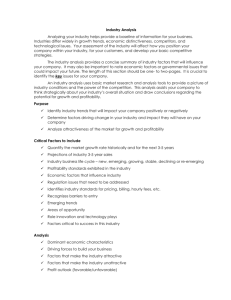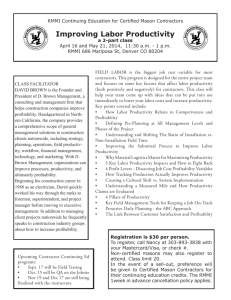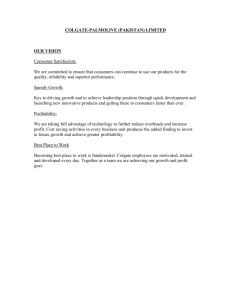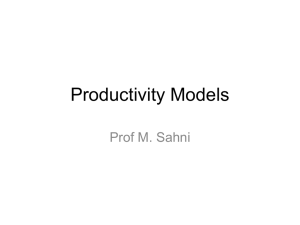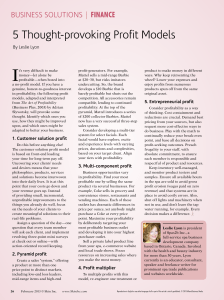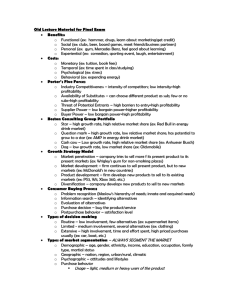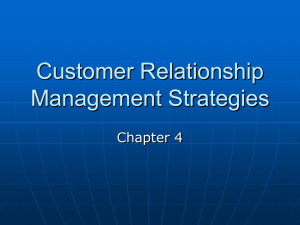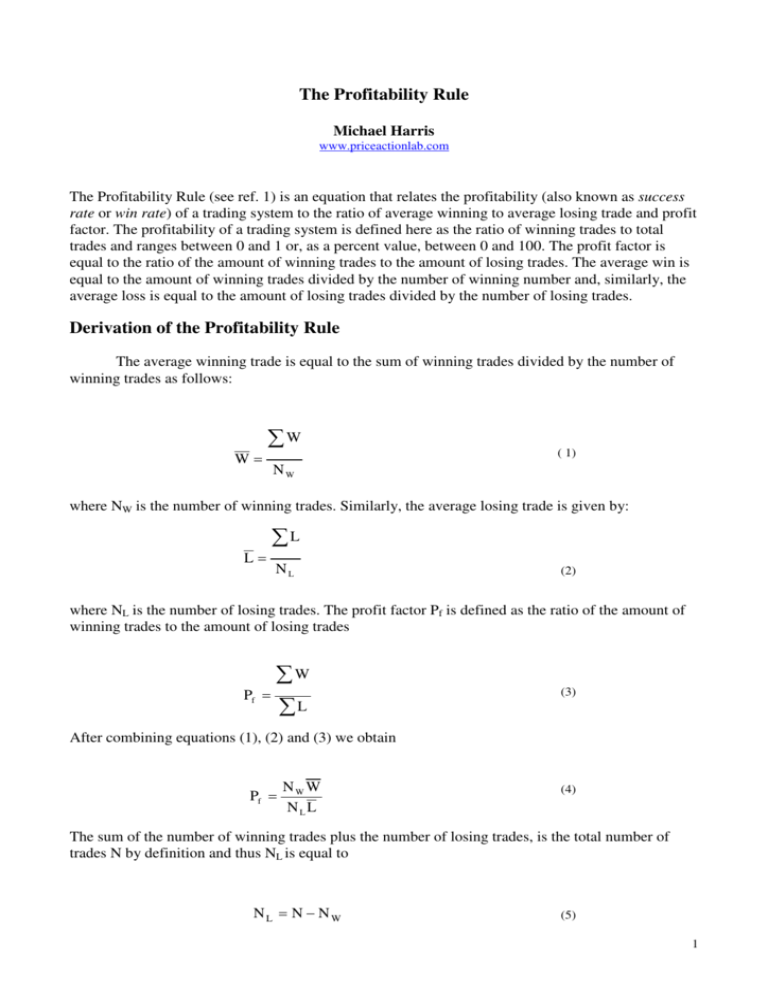
The Profitability Rule
Michael Harris
www.priceactionlab.com
The Profitability Rule (see ref. 1) is an equation that relates the profitability (also known as success
rate or win rate) of a trading system to the ratio of average winning to average losing trade and profit
factor. The profitability of a trading system is defined here as the ratio of winning trades to total
trades and ranges between 0 and 1 or, as a percent value, between 0 and 100. The profit factor is
equal to the ratio of the amount of winning trades to the amount of losing trades. The average win is
equal to the amount of winning trades divided by the number of winning number and, similarly, the
average loss is equal to the amount of losing trades divided by the number of losing trades.
Derivation of the Profitability Rule
The average winning trade is equal to the sum of winning trades divided by the number of
winning trades as follows:
∑W
W=
( 1)
NW
where NW is the number of winning trades. Similarly, the average losing trade is given by:
∑L
L=
NL
(2)
where NL is the number of losing trades. The profit factor Pf is defined as the ratio of the amount of
winning trades to the amount of losing trades
∑W
Pf =
∑L
(3)
After combining equations (1), (2) and (3) we obtain
Pf =
NW W
NLL
(4)
The sum of the number of winning trades plus the number of losing trades, is the total number of
trades N by definition and thus NL is equal to
NL = N − NW
(5)
1
Next, from the definition of the ratio of average winning to average losing trade, RWL, we have:
R WL =
W
L
(6)
After introducing equations (5) and (6) into equation (4) we obtain
NW
R WL
N− N W
Pf =
(7)
Next, we divide the numerator and denominator of equation (7) by N
NW
Pf = N R WL
N
1− W
N
(8)
The profitability P of a trading system is defined as the ratio of the number of winning trades to the
total number of trades. P takes values in the range 0 and 1 (or 0% to 100%):
P=
NW
N
(9)
(9)
After combining equations (8) and (9), we get the following expression for Pf
Pf =
P
R WL
1− P
(10)
Finally, after solving for P in equation (10) above we obtain the result
P=
1
R
1 + WL
Pf
or P =
Pf
Pf + R WL
(11)
Equation (11) is the Profitability Rule. It is an equation that relates the profitability P to the profit
factor Pf and ratio of average winning to average losing trade RWL. Given the values of the profit
factor and ratio of average winning to average losing trade, using equation (11) one can determine
the corresponding profitability. If the values of the profitability and ratio of average winning to
2
average losing trade are known instead, then equation (10) can be used to calculate the resulting
profit factor. Alternatively, equation (10) can be solved for the ratio of average winning to average
losing trade required given the values of profitability and profit factor, as follows
R WL =
1− P
Pf
P
(12)
Figure 1 shows a 3-D graph of equation (11). The profitability P is plotted versus RWL and Pf, for
values ranging from 0 to 10.
Figure 1: A 3-D graph of the Profitability Rule. Source: Mathematica.
Figure 2 shows a 2-D graph of the profitability P versus a single parameter, which is equal to the
ratio RWL /Pf. It may be seen from the graph in Figure 2 that the required profitability increases fast
as the value of the ratio RWL /Pf. drops below 4 but it is comparatively low for values of the ratio
much larger than 4.
3
Figure 2: A 2-D graph of the Profitability Rule. Source: Mathematica
RWL
10
5
2
1
0.5
0.25
0.125
Required Profitability P (x100)
16.67%
28.57%
50.00%
66.67%
80.00%
88.88%
94.11%
Table 1: Required profitability as a function of the ratio of average winning to average losing trade for a profit
factor equal to 2.
Table 1 shows the required profitability of a trading system for various values of the RWL parameter,
computed using equation (11). The profit factor is set equal to 2. As RWL increases the required
profitability of a trading system decreases for a constant profit factor. Regarding the parameter RWL,
the following observations can be made from equation (11):
(1): Trading systems with low RWL values must have high profitability, which implies a much larger
number of winning trades than losing trades. This is the case with intraday or scalping trading
systems. Intraday traders must have a high rate of success to stay profitable over the longer term.
(2): Trading systems with high RWL values can have low profitability, meaning that they can
generate fewer winning trades than losing trades and still stay profitable. This is the case with trend
following systems that have a few large winners and many small losers.
(3): The ratio RWL/Pf in equation (11) is an important parameter. It is evident that values of the profit
factor Pf much greater than 1 reduce the effectiveness of higher RWL values and thus increase the
required profitability.
RWL
10
10
5
5
2
2
1
1
0.5
0.5
Profit Factor Pf
2
3
2
3
2
3
2
3
2
3
Required Profitability P%
16.67
23.07
28.57
37.50
50.00
60.00
66.67
75.00
80.00
85.71
Table 2: Required profitability for various values of the ratio of average winning to average losing trade and
profit factor
4
Table 2 shows values of the required profitability for various values of the ratio of average winning
to average losing trade and profit factor. For each value of the ratio RWL, two different values of the
profit factor Pf are considered to illustrate the effect of the increased demand for higher profitability.
This effect is also illustrated in Table 3 where the influence of the profit factor on profitability is
considered for a constant RWL value of 1. Notice, for example, that for a profit factor equal to 2 and a
ratio of average winning to average losing trade equal to 1, the required profitability is 66.67%. If the
profit factor is increased to 3, the required profitability is increased to 75.00%.
Pf
1.00
1.25
1.50
1.75
2.00
2.50
3.00
Minimum Required Profitability P (x100)
50.00%
55.56%
60.00%
63.64%
66.67%
71.43%
75.00%
Table 3: Required minimum profitability as a function of the profit factor for a constant ratio of average winning
to average losing trade equal to 1.
The Profitability Rule and Trading Time Frames
Typical value of the parameter RWL, the ratio of average winning to average losing trade, in the case
of short-term or intraday trading systems are between 0.25 and 2. If the profitability (success rate) is
maintained above its required value, as calculated by the Profitability Rule of equation (11), the
system will always perform according to expectations. Trend following systems on the other hand
require RWL values much greater than 3. This is due to the fact that in trend following systems the
objective is to minimize loses that occur during sideways markets and maximize profits realized
during price trends.
However, in the case of trend following systems, future RWL values are inherently uncertain and may
not match any values obtained during back testing. This is because the magnitude of future price
trends is unpredictable and at the same time the performance of position exit methods used depends
on price volatility. Since both the magnitude of future trends and associated volatility cannot be
known in advance, there is a possibility that future values of the parameter RWL may be lower than
the ones obtained from back testing. Therefore, in the context of the Profitability Rule, a given level
of profitability of a trend following system could guarantee a minimum profit factor only if future
trends have comparable magnitude as in the past and the same or lower price volatility to guarantee
the effectiveness of position exit methods. This conclusion arises from the stochastic nature of the
Profitability Rule in the case of trend following systems, in which case the parameter RWL is a
random variable. This also explains why profitable trend-following systems based on back testing
often fail when used in actual trading.
Next, we will look at three examples of the use of the Profitability Rule.
Example 1: A short-term position trader of E-mini futures realizes a net profit of $1000 in each
winning trade ($1000 target) and a net loss of $500 in each losing trade ($500 stop-loss). The trader
is profitable 7 times out of ten over a sufficiently long period of time. (a) What is the trader’s profit
5
factor? (b) By what factor the actual profitability exceeds the required profitability for break-even
performance?
(a) First we calculate the ratio of average winning to average losing trade as follows:
RWL = $1000/$500 = 2.0
Since P = 70%, from equation (10) can we calculate the profit factor Pf
Pf = (0.7 x 2.0) /(1.0 - 0.7) = 4.67
Thus, the amount of winning trades will be 4.67 times the amount of losing trades over a sufficiently
long period of time.
(b) The required profitability for break-even performance (amlount of winners = amount of losers) is
found by applying equation (11) with Pf = 1.
Pmin = 100/(1+2.0) = 33.33 %
The trader’s profitability P exceeds Pmin by a factor equal to
100 x (70% -33.33%)/33.33% = 110%.
Example 2: System A is as profitable as system B but A has three times the ratio of average winning
to average losing trade of B. How do their profit factors compare?
For system A:
PfA = [P/(P-1)] x RWLA
Similarly for trader B;
PfB = [P/(P-1) x RWLB
After dividing PfA by PfB we get
PfA/PfB = RWLA/RWLB
Since RWLB = 3 x RWLA we obtain:
PfA/PfB = 1/3
Thus, if the profitability stays constant, any increase in the ratio of average winning to average
losing trade results in a proportional increase in the profit factor.
Example 3: A trend following system has profitability P equal to 30% and uses a stop-loss of
$1,000. How large should the average winning trade be so that he will end up with a profit factor
equal to 4?
6
From equation (12) we obtain:
RWL = [(1-P)/P] x Pf = [(1-0.3)/0.3] x 4.0 = 9.33
RWL = avg. win/avg. loss = avg. win / $1,000 = 9.33
Result: avg. win = 9.33 x $1,000 = $9,333.
Thus, the average winning trade must be at least $9,333 to maintain a profit factor of 4.0 when the
profitability stays at 30% and the average loss is $1,000.
Note that if the profitability were to increase to 40%, then:
RWL = [(1-P)/P] x Pf = [(1-0.4)/0.4] x 4.0 = 6.0
RWL = avg. win/avg. loss = avg. win / $1,000 = 6.0
Result: avg. win = $6,000
Thus an increase in the profitability by a factor of 1.33 reduces the required avg. win by a factor of
1.56 ($9,333/$6,000).
Comments
One should always keep in mind that under actual market conditions commissions and slippage can
adversely affect the expected performance of trading systems. Essentially, what is affected is the
average win to average loss ratio. The actual profitability may end up dropping below the expected
level or even below the breakeven value in some cases. In order to account for the influence of
unknown or random factors it is recommended to include a ‘safety factor” in equation (11) as
follows:
P=
Pf
Pf + α R WL
where the safety factor α takes values between 0 and 1. In the case of intraday and short-term trading
systems, values for α in the range 0.7 to 0.9 are recommended. In the case of trend following
systems, since future RWL values are random, lower values for the safety factor are recommended in
the range 0.3 to 0.7.
The Profitability Rule is an equation that relates the profitability of a trading system to the ratio of
average winning to average losing trade and profit factor. The equation derived in this article plays
an important role in the analysis and synthesis of trading systems and exposes their performance
limitations. The profitability rule provides, amongst other things, a quantitative means of evaluating
alternative systems with different risk/reward and performance parameters. After all, it is not the
absolute values of the risk/reward ratio, profitability and profit factor that are important, but the way
they are related, as the Profitability Rule tells us in the form of an elegant equation. Regardless of the
methodology used to develop trading systems, all traders should remember that trading involves high
7
financial risks and it can result in total loss of capital and it is suitable only to those that can afford to
lose.
References
Profitability and Systematic Trading (Wiley, 2009). For more details see:
http://www.wiley.com/WileyCDA/WileyTitle/productCd-047022908X.html
For more papers by Michael Harris please follow the URL below:
http://www.priceactionlab.com/Literature/literature.html
Copyright © 2010 Michael Harris, All rights Reserved.
8


